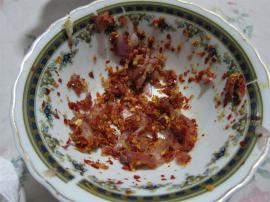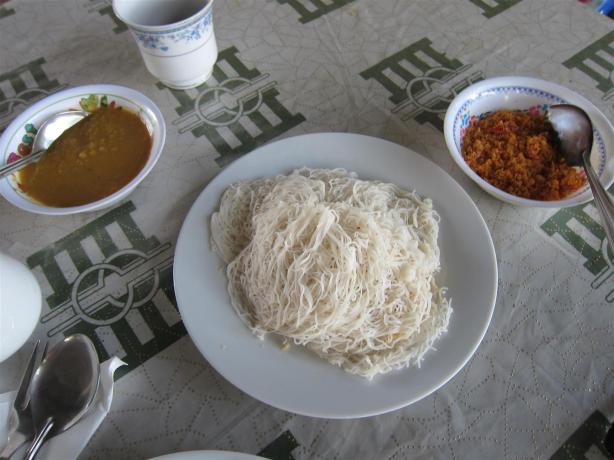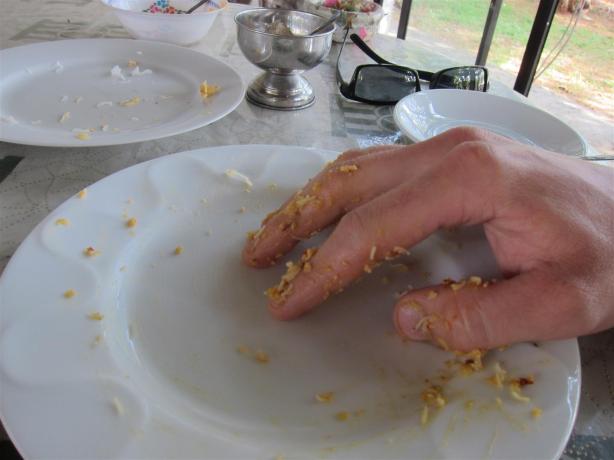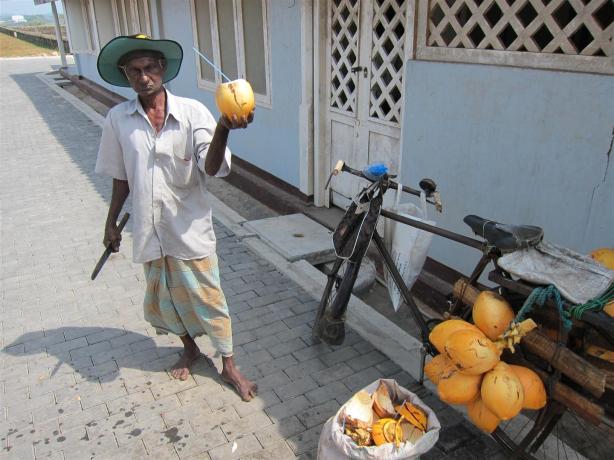A new series! Check it out, I’m like Anthony Bourdain, but much less qualified, respected and successful…
the basics: ten fingers, toes and chilies for each plate
Spicy, strong flavors, lots of carbs, and clearly inspired from Tamil (Southern Indian) food, I love the food in Sri Lanka. Curries, masalas, ground coconut, chilies and saffron make up for rich, intense tastes, and when it’s good, it’s really good. Though not nearly as diverse as the options in India, the following are the basic and most easily found dishes. Everything is eaten with your right hand, and even soups are generally served in cups. Most restaurants have spoons on request, but going local is preferable, and not just for the experience: some foods simply have to be eaten by hand anyway, and I’ll never forget the first time I was told (this mantra was repeated to me by many), of rice and curry, that “There is no point in eating this food with a spoon. You will not get the flavors.” I know that sounds ludicrous, but I found it to be true. Part of it is that you cannot mix the food in the same way. It’s common to have several curries and veggies served separately, and the mixing of them not only makes every bite just a bit different, but getting the proper consistency requires you to thoroughly mix the rice with the curry, completely covering and spicing every single grain. This doesn’t sound like a big deal, but if you eat one plate with a spoon and another with five fingers, the difference becomes obvious.
The other part of it is even harder to really explain. Obviously, there are tons of foods eaten exclusively by hand in all cultures and countries (except by Donald Trump, but he’s more of a robot anyway), but in many countries, everything is eaten by hand, and eating a food (particularly one as seemingly unweildy as rice and curry) with your hands connects you to it in a way, makes you focus, makes you more mindful of what’s going into your mouth. It’s true: I found the food simply tasted better, and that line, “There is no point eating this food with a spoon” echoed with each meal… I think Bourdain was really on to something when he wrote that food tastes better with bare feet. I’ve preached this mantra plenty over the years, and maybe this is just the natural extension of that. By my second week here, I was eating every meal with bare hands and bare feet. I highly recommend trying this, no matter where you are and what you’re chewing…
Rice and Curry
Truly the national dish, though obviously no nation can truly lay claim to it. It sounds like a simple meal, but generally “Rice and Curry” can be construed as “Rice and four to six different curries”, sometimes served as sides, sometimes served in a neatly striped pile, and often self-serve. Out of perhaps 50 or so meals of Rice and Curry, I can confidently say that no two are ever alike, and that is the broadness of the whole meal: obviously there are veg and non-veg curries, stewed options, steamed veggies, fried bits and more, and there are really endless possibilities… here are some visuals to chew on…

clockwise from left: a big ol' red chili, red rice (on the whole plate.. duh), stewed green beans with chili, fried roti (sort of like tortilla chips), lentil dhal, steamed spinach, and pan-fried jackfruit. all veg, all delicious

left to right: beef curry, a sort of broiled chicken, rice, stewed root veggies, dhal. the little dish on the bottom was this lovely yogurt/onion/chili chutney
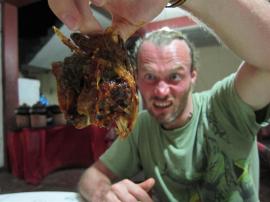
I totally ate the cheeks out of this little guy. the fish, that is, not the nice Belgian fellow holding it...
Dhosa/Paper Dhosa/Masala Dhosa
These are… just awesome. Basically the dhosa itself is a crepe-like bread, always made fresh (if it’s worth a damn). You can purchase the batter by the bag/bucket in stores, but again, if it’s worth a notion, it will be home-made. Here again is a food you can eat hundreds of times and always have a different meal: the batters are sometimes a bit sour, sometimes just a little sweet, but always different. My favorites have a strongly fermented, sourdough taste to them, and in Kandy, after trying three or four shops, I stuck to the one guy. Plain dhosa is just like it sounds: a huge freakin’ dollop of fresh batter, with nothing on it. Paper dhosa is also pretty self-explanatory: like a dhosa, but thinner and more crumbly (think pan pizza vs thin crust). These are generally more expensive than their bigger kin, as it’s simply harder to make it thin without burning it, making itmore labor intensive. Masala dhosa is a plain dhosa with spiced chunks of potato (and sometimes other veggies) mixed inside. All of these are eaten with Dhal, Chutneys and Curries, none of which you technically pay for (in shops, guys just walk around with cute little 4-leaf-clover buckets full of them). A good plain dhosa will generally set you back about 60 rupees (about $.60), and I don’t think I ever paid more than 130 rupees for a Masala dhosa, which makes them nice, cheap, fast and tasty. I have eaten four in one sitting (well, standing – that was a street vendor, where they’re typically about 16 rupees each instead of 60) to the great pleasure and amusement of the vendor: one is usually filling.

This is the standard option. The little bucket-looking thing is loaded with dhal, potato curry and a spicy chutney...

curries and such are made off-site, delivered by tuk-tuk, piping hot. here J and company load in fresh dhal
String Hoppers
Imagine the same basic principle of the Dhosa or Rice and Curry (carbs+curries=awesome) but replace the carbs with patties of rice noodles, then serve it next to only mild curries (like Dhal), and Sambal, which is ground coconut with chili and other spices. If you like noodles, your mouth should be watering at this point. Generally treated as breakfast food, this is something I’d never seen before (although I’ve now had the same thing in India, as a form of idly), and it was really, really hard to not gorge myself on this every day. The great thing about hoppers is that you pretty much have to eat them with your hands; you simply can’t do it otherwise. First, take a paddy, some dhal, and some sambal, and then just mince it together with your fingers, mixing in the curry to make it the right consistency. Then work it into a ball with your thumb and all your fingers (it’s easier to do this with hoppers than it is with rice, as the noodles sort of congeal with the curry), pinch it, slide your thumb across to shove the ball into your mouth, and savor that awesome flavor. Crazy whackos like me can add more chili paste, but be prepared: even the locals will look at you funny for doing this, as it is breakfast, after all, and is considered more “temperate” food. I made the diagram of eating food with five fingers with hoppers instead of rice because the pictures are prettier:

fig D: the thumb is used like a spoon (really, more like a shovel) to sweep the food into your awaiting gullet. your fingers should not enter your mouth while eating...
Along the path, I met a lot of other travelers who never once tried these. If you go, do not follow their example, particularly if you are a noodle geek like me…
Roti: a versitle bit of dough
Roti is perhaps the most common, and diverse, eats on the go. Plain roti is very similar to a tortilla, much thicker than dhosa but generally smaller. It’s made from a dough rather than batter, less like a crepe and more like leavened bread, just a bit thicker than nan . Sometimes it’s served with dahl, or some other curry, sometimes just chili paste, sometimes dry, in a stack (it’s rarely made fresh in front of you). Fancy-pants roti is generally a much bigger piece, folded over with fillings such as veggies, cheese, meat and curry — except for the fact that it’s square instead of rolled, it’s very similar to a burrito, really. Generally, a veggie option will set you back 70-100 rupees, with meat varieties being about twice as much. New Muslim Hotel in Kandy is particularly renowned for their rotis, and here is their steak option:
which is perhaps not the prettiest picture (at this restaurant, the roti was cut up in front of me with two spoons, which was so amusing that I chose not to argue for the sake of cleanly framed photographs) but should get the point across. That particular one is steak, onions, spinach, tomato, and a light sauce. I wasn’t very hungry when I came in, but ate two of these. The spoons seemed a tad dull by the second… I considered saying something but held my tongue.
British Food
It has to be said: relatively British fare is widely available in the cities, mostly ending up as bar food in pubs and such. Fried is the key word here, and it is generally over-salted, like most bar food, to make you drink more. Still, at some places, it’s really quite delicious: at the Royal Pub in Kandy, the batter is very light, with just a bit of chilli, and some citrus highlights. They do local mushrooms there that are, in a word, amazing. I ate them nearly every day. Their other mildly addictive dish isn’t even on the menu; David called them “saltfish” (as a Brit, I figured he’d know) but these are not salt-preserved fish, but rather small fish that are battered and fried whole (apparently very common in pubs in Britain). These plates were relatively expensive (the mushrooms were about 380 rupees a plate, enough for four or five dhosas) but the beer at this fine establishment is drought, fresh, and only 120 rupees a pint (oddly, not an imperial pint) so it sort of balances out.
Honorable Mention: king coconuts
Obviously not a particularly “national” food, I have to mention them anyway. For starters, they’re quite delicious, and the coconut water within is as fresh as you’ll get, nearly bursting from the thing as the knife strikes the surface. Secondly, this is a very good thing to drink on 36c days that are spent in the sun, as coconut water is loaded with electrolytes and sugary goodness, rehydrating you quickly. I drink and eat at least one of these a day, sometimes three or four. I think even more than that, though, I like that they are almost exclusively sold by bicycle, often by people who have almost nothing, as all you need to get into business is a bike, a blade, and access to king coconuts, which are no rare thing in Sri Lanka.
You also get a built-in chance to talk to each vendor for a few minutes, because if you stick around, when the water is gone, they’ll chop the thing into halves, chip of a piece of coconut for you to use as a spoon (a sanitary, biodegradable spoon) and you get to gorge out the fruit. These conversations are fun, when you can have them (many vendors speak very little english) and a pretty transparent window to the lower class here. I met one man (his name sounded like ‘At-heed-a’) who lived in a one room shack with his wife and two children. His wife washed clothes for money on the riverbank across from their home, about a kilometer from his regular coconut spot, across from a temple in a quiet neighborhood with little foot traffic. Both children were in school. His cache of goods were mostly stored at home, and when he ran out of coconuts, he simply went into the jungle to get more (which sometimes involves serious climbing) or he could buy them from another man who sold them out of his tuk-tuk for perhaps 1/3 of retail. He seemed pretty happy, and certainly well fed. Sometimes, though, the vendors’ stories were different…
ego trippin’: a tale of two coconuts
A few weeks ago, while in Puducherry (very much not in Sri Lanka), I met one pair of ladies who worked on the same corner, but not together. My buddy Henry had designated one as his coconut mama and frequented only her, as I had done to Atheeda and many other food vendors. After the second time I went there, I wondered about them a bit more.
“It’s weird that they’re on the same corner… you think those two get along?”, I asked while we were walking away.
“Hmm? Oh, I don’t think so… they don’t speak to each other.”
“Wait… like, you haven’t seen them talk to each other, or you asked and she told you that?”
“No, I asked. I thought it was interesting that they worked the same corner but clearly weren’t working together, so I asked… anyway, she told me they used to speak – I think they even worked together, as partners – but yeah, they don’t anymore. I asked her how long ago that was and she just said ‘years’.”
I considered the implications of this. They were both probably in their late forties or early fifties… Wow! This was… very interesting. They work next to each other for 12+ hours a day and won’t speak.
“Actually,” he went on, “one day I didn’t have enough change to pay here, and she said ‘tomorrow’, and when I went back the next day, she wasn’t there. I asked the other lady if she would give her the 15 rupees for me, but she just shook her head and said ‘later’. So I went back later and paid her.”
“So… let’s get this straight… they won’t talk to each other, even enough to exchange 15 rupees… but she didn’t just take your money and keep it. That would mean that not only is she honest, she may be spite-less as well, maybe even traces of some honor or good intention mixed in there…”
“Yeah, I thought about that too.”
“And why doesn’t one just move? Even, like, across the street? Is it like a turf thing? Or just pride? I wonder what happened to male them stop speaking…”
“Yeah, it’s weird, I think they generally only work one the same days, too; I walked by the other day and neither of them were there…”
We never found out. I think about them sometimes. I’ve decided it’s all pretty hip-hop, actually, refusing to leave your corner after splitting shop with your partner. A corner beef. With coconuts.
